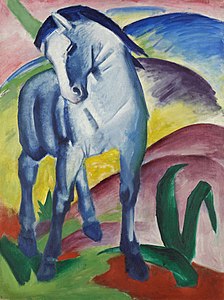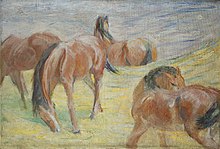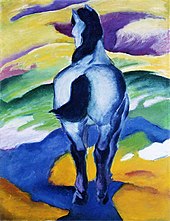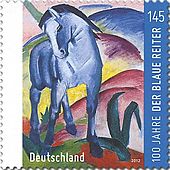Blue horse I

|
| Blue horse I |
|---|
| Franz Marc , 1911 |
| Oil on canvas |
| 112 × 84.5 cm |
| Municipal gallery in the Lenbachhaus , Munich |
Blue horse I is the title of a painting by Franz Marc (1880–1916). It is one of the painter's best-known pictures and is part of the collection of the Städtische Galerie im Lenbachhaus in Munich . The picture was part of several exhibitions that Wassily Kandinsky and Franz Marc presented to the public under the name Der Blaue Reiter from late 1911 until the beginning of World War I in 1914.
description
The picture is 112 cm high and 84.5 cm wide. It was painted on canvas with oil paint .
Almost the entire height of the portrait-format picture is taken up by a foal , painted in blue , facing the viewer and tilting its head slightly to one side. The upper body is light blue with white spots, while the hooves and mane are painted in dark navy blue.
The landscape in which the foal is seated is dominated by strong contrasts of complementary colors , some of which are sharply delineated. The foreground is in vermilion red and light green, strong dark green brushstrokes indicate vegetation. The hilly landscape indicated in the background changes from carmine to yellow, violet and blue to orange at the top of the picture.
history
The painting was created in 1911. In the color theory of Marc and the Blue Rider, the blue color represents the spiritual principle. According to the art historian and Marc specialist Klaus Lankheit , Marc finally penetrates with this picture from the natural "appearance color", as he did, for example, in his painting Grazing Horses I from 1910 and also in the painting Horses, which was already painted in blue who had used willow from the same year, to the "essence color".
The image was initially not understood and was laughed at or even spat upon. It was part of the private collection of Bernhard Koehler , who supported Franz Marc financially and received pictures by the painter in return. In 1927 he bequeathed his collection to his son, who was also named Bernhard. After his death, the picture was donated to the Städtische Galerie im Lenbachhaus by the Bernhard Koehler Foundation in 1965 and exhibited there. Only then did it gain greater popularity. As a popular poster and postcard motif, it is now one of the most frequently reproduced paintings in recent art history.
More blue horses
Franz Marc also took up the motif of the blue horse in other pictures, including in
- Blue Horse II , 1911
- The great blue horses , 1911
- The little blue horses , 1911
- Red and Blue Horse , 1912
- Blue horse , 1912
- Blue foals , 1912
- Dreaming horse , 1913
- Two blue horses , 1913
- The blue foals , 1913
- The Tower of the Blue Horses , 1913
Others
On February 9, 2012, Deutsche Post AG issued a special stamp worth 145 euro cents with the motif of the painting on the occasion of the 100th anniversary of the Blue Rider .
Web links
- Blue horse I on the website of the Städtische Galerie im Lenbachhaus
- Thomas Kempe: Icon of Modern Art: Why the Blue Horse? In: Bayerischer Rundfunk . March 14, 2014 ( br.de [accessed February 18, 2020]).
Individual evidence
- ^ A b Franz Marc, Blue Horse I, 1911. In: lenbachhaus.de. Städtische Galerie im Lenbachhaus, accessed on February 17, 2020 .
- ↑ Thomas Kempe: Icon of Modern Art: Why the Blue Horse? In: br.de. March 14, 2014, accessed February 18, 2020 .
- ^ Franz Marc: picture "Blue Horse". In: sueddeutsche.de. Süddeutsche Zeitung, accessed on February 18, 2020 .
- ↑ Stefan Dege: "The Blue Rider": Franz Marc was born 140 years ago. In: dw.com. Deutsche Welle, February 7, 2020, accessed on February 18, 2020 .



